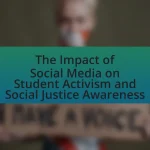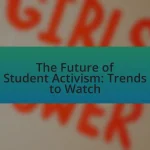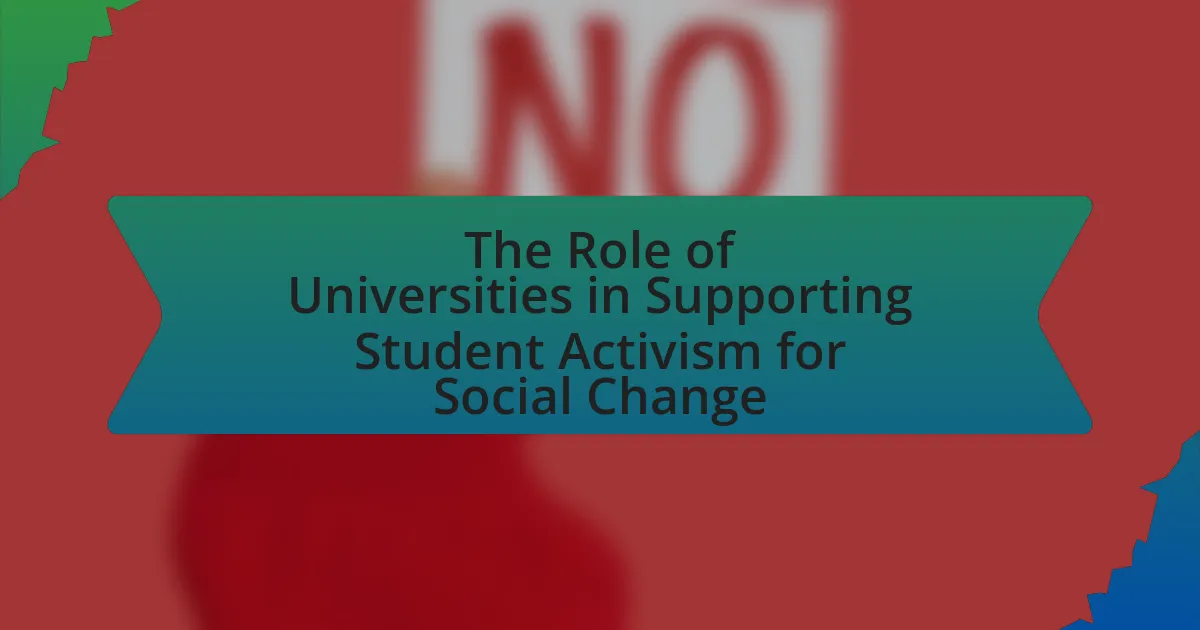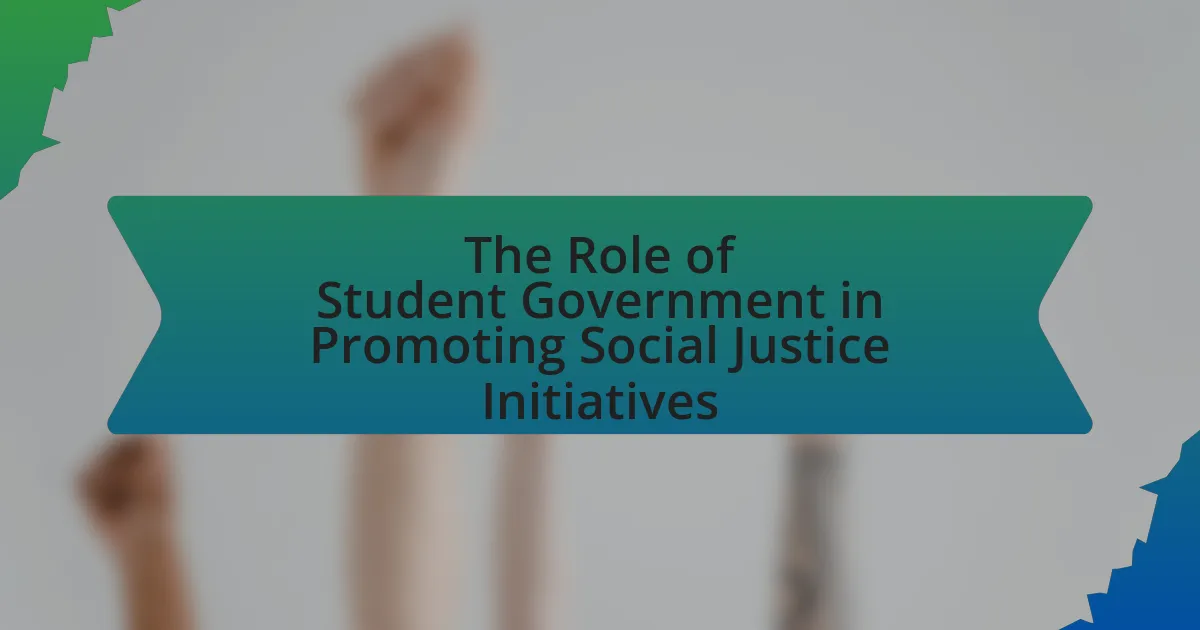The article examines the impact of COVID-19 on student activism and social justice efforts, highlighting how the pandemic has intensified awareness of systemic inequalities and mobilized students globally through digital platforms. It discusses the emergence of specific movements, such as Black Lives Matter and climate justice activism, and how existing movements adapted to online organizing. The article also addresses the challenges faced by student activists during the pandemic, including mental health impacts and restrictions on gatherings, while emphasizing the importance of student engagement in advocating for social change. Additionally, it explores the long-term implications of these developments on future activism and the strategies students can employ to enhance their efforts post-pandemic.
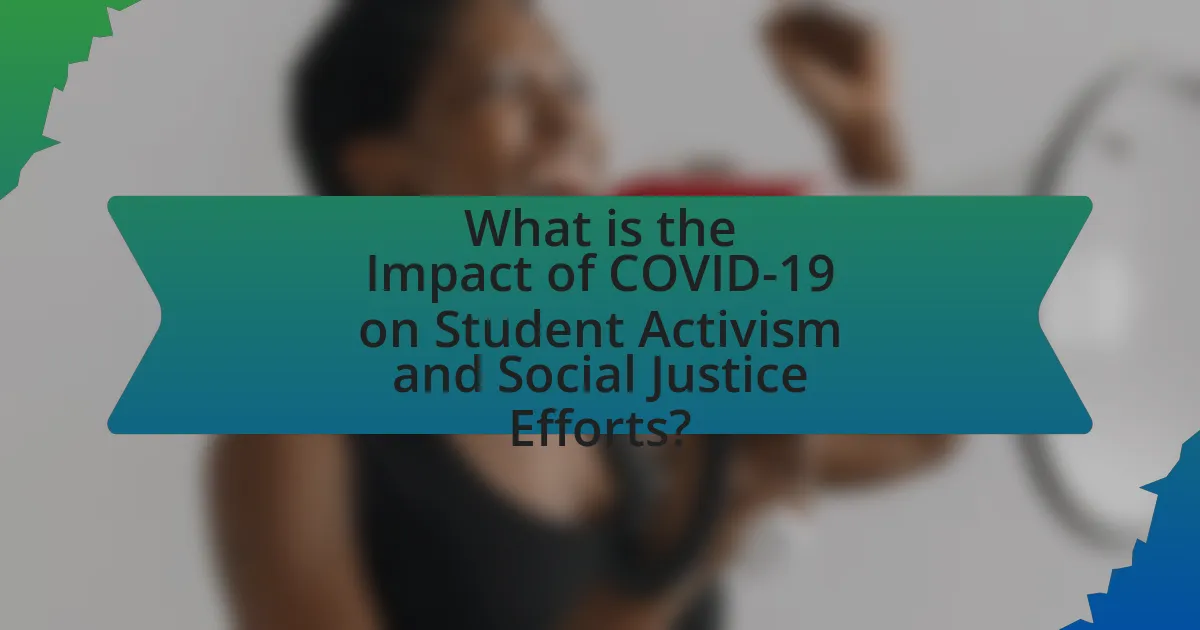
What is the Impact of COVID-19 on Student Activism and Social Justice Efforts?
COVID-19 has significantly amplified student activism and social justice efforts by catalyzing a surge in online organizing and awareness of systemic inequalities. The pandemic highlighted disparities in healthcare, education, and economic stability, prompting students to mobilize around issues such as racial justice, climate change, and mental health. For instance, the Black Lives Matter movement gained momentum during the pandemic, with students participating in virtual protests and campaigns, as evidenced by a 2020 Pew Research Center survey indicating that 55% of young adults supported the movement. Additionally, the shift to remote learning exposed educational inequities, leading students to advocate for equitable access to resources and support. This increased engagement reflects a broader trend of youth activism that has been documented in various studies, including the “Youth Activism in the Time of COVID-19” report by the Center for Information & Research on Civic Learning and Engagement, which found that young people are more likely to engage in social justice activities during crises.
How has the pandemic influenced student activism globally?
The pandemic has significantly amplified student activism globally by increasing awareness of social justice issues and mobilizing students through digital platforms. As educational institutions shifted to online learning, students utilized social media to organize protests and advocate for causes such as racial equality, climate action, and mental health support. For instance, the Black Lives Matter movement gained momentum during the pandemic, with students leading virtual demonstrations and campaigns, highlighting systemic racism and police brutality. Additionally, a survey conducted by the Institute for Democracy and Electoral Assistance in 2021 revealed that 70% of young people felt more motivated to engage in activism due to the pandemic’s social and economic impacts. This shift demonstrates how the pandemic has not only heightened the urgency of social issues but also transformed the methods of student activism, making it more accessible and widespread.
What specific movements have emerged during the pandemic?
During the pandemic, specific movements such as Black Lives Matter, climate justice activism, and mental health awareness initiatives have emerged prominently. The Black Lives Matter movement gained renewed momentum following the murder of George Floyd in May 2020, leading to widespread protests advocating for racial justice and police reform. Climate justice activism saw increased participation as the pandemic highlighted environmental issues, with youth-led organizations pushing for sustainable policies. Additionally, mental health awareness initiatives gained traction as the pandemic exacerbated mental health challenges, prompting campaigns focused on destigmatization and access to mental health resources. These movements reflect a significant shift in student activism and social justice efforts during the COVID-19 crisis.
How have existing movements adapted to the challenges posed by COVID-19?
Existing movements have adapted to the challenges posed by COVID-19 by shifting to digital platforms for organizing and mobilization. For instance, many social justice groups transitioned their campaigns online, utilizing social media and virtual meetings to maintain engagement and outreach. This adaptation allowed movements like Black Lives Matter to continue their advocacy through online petitions, virtual protests, and digital education initiatives, effectively reaching a broader audience despite physical distancing measures. Additionally, the pandemic highlighted issues such as healthcare inequality, prompting movements to incorporate these themes into their agendas, thereby aligning their goals with the urgent needs of the moment.
Why is student activism important in the context of social justice?
Student activism is crucial in the context of social justice because it mobilizes young people to advocate for systemic change and raise awareness about social issues. Historically, student movements have played a pivotal role in advancing civil rights, environmental justice, and educational reforms, exemplified by the 1960s civil rights protests and the more recent climate strikes led by youth activists. These movements demonstrate that students can influence public policy and societal norms, as seen in the increased attention to racial inequality following the Black Lives Matter protests initiated by students. The engagement of students in activism fosters a culture of critical thinking and civic responsibility, essential for a democratic society.
What role do students play in advocating for social change?
Students play a crucial role in advocating for social change by mobilizing their peers, raising awareness, and influencing policy decisions. During the COVID-19 pandemic, students have utilized digital platforms to organize protests, share information, and engage in discussions about social justice issues, such as racial inequality and climate change. For instance, the Black Lives Matter movement saw significant student involvement, with many universities hosting virtual events and campaigns to address systemic racism. This engagement not only amplifies marginalized voices but also pressures institutions and governments to implement reforms, demonstrating the effectiveness of student activism in driving social change.
How does student activism contribute to broader social justice efforts?
Student activism significantly contributes to broader social justice efforts by mobilizing young people to advocate for systemic change and raise awareness about social issues. For instance, during the COVID-19 pandemic, student-led movements addressed inequalities in education, healthcare, and racial justice, highlighting disparities faced by marginalized communities. Research from the Harvard Kennedy School indicates that student activism has historically played a crucial role in shaping public policy and influencing social movements, as seen in the Civil Rights Movement and more recently in climate justice initiatives. This activism not only amplifies the voices of underrepresented groups but also fosters solidarity among diverse communities, ultimately driving societal change.
What challenges have students faced in activism during the pandemic?
Students have faced significant challenges in activism during the pandemic, primarily due to restrictions on in-person gatherings and the shift to virtual platforms. These restrictions limited their ability to organize protests and engage in face-to-face discussions, which are crucial for mobilizing support and building community. Additionally, the digital divide exacerbated inequalities, as many students lacked access to reliable internet or technology, hindering their participation in online activism. According to a report by the Institute for Democracy and Electoral Assistance, youth engagement in political activities dropped by 20% during the pandemic, highlighting the impact of these challenges on student activism.
How have restrictions on gatherings affected student-led initiatives?
Restrictions on gatherings have significantly hindered student-led initiatives by limiting opportunities for in-person collaboration and activism. For instance, many student organizations have reported a decline in participation and engagement due to the inability to hold events, meetings, and rallies, which are crucial for mobilizing support and fostering community. According to a survey conducted by the National Student Association in 2021, 65% of student groups indicated that their activities were severely impacted by gathering restrictions, leading to a shift towards virtual platforms that often lack the same level of effectiveness in building momentum and solidarity. This shift has resulted in a decrease in the visibility and impact of student-led social justice efforts during the pandemic.
What mental health impacts have students experienced while engaging in activism?
Students engaging in activism have experienced increased anxiety, depression, and burnout. Research indicates that the emotional toll of activism, particularly during the COVID-19 pandemic, has heightened feelings of isolation and stress among students. A study published in the Journal of Youth Studies found that 70% of student activists reported mental health challenges linked to their activism efforts, exacerbated by the pressures of social media and the urgency of social justice issues during the pandemic. This data underscores the significant mental health impacts that activism can have on students, particularly in a crisis context.
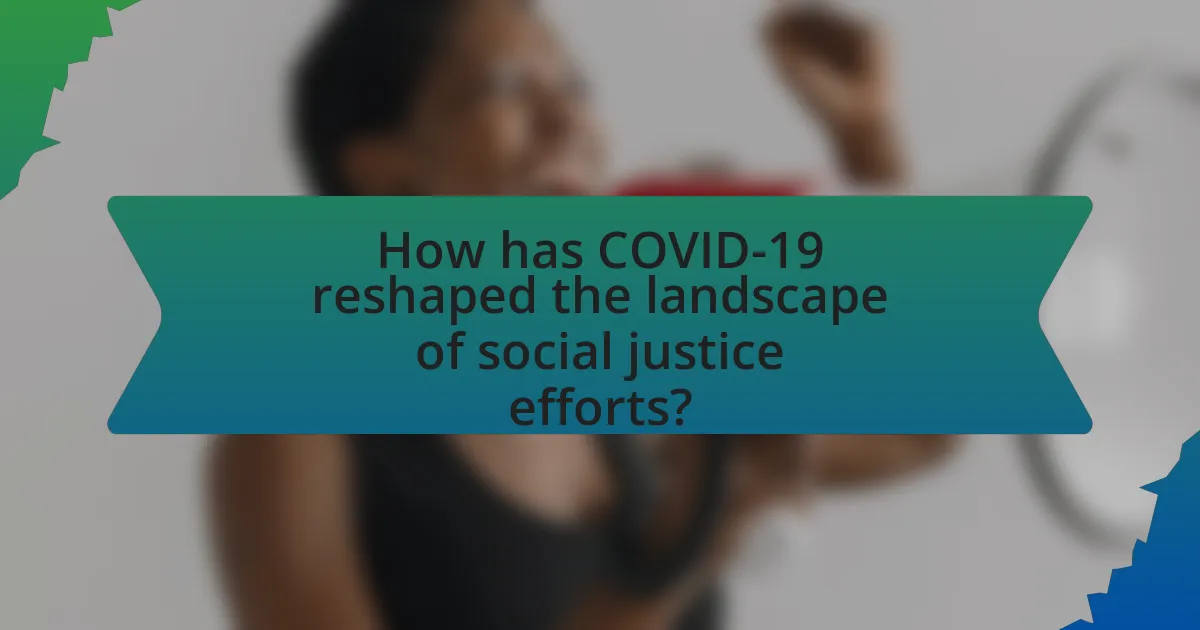
How has COVID-19 reshaped the landscape of social justice efforts?
COVID-19 has significantly reshaped the landscape of social justice efforts by amplifying existing inequalities and mobilizing grassroots activism. The pandemic highlighted disparities in healthcare, economic stability, and access to education, prompting a surge in movements advocating for racial and economic justice. For instance, the Black Lives Matter protests gained momentum during the pandemic, with a reported 15 million to 26 million participants in the U.S. alone, marking one of the largest movements in American history. Additionally, the crisis led to increased online organizing and virtual activism, allowing diverse voices to engage in social justice discussions and actions despite physical distancing measures. This shift has resulted in a more interconnected global movement, as activists leveraged digital platforms to share resources and strategies, ultimately transforming the approach to social justice advocacy.
What new strategies have students employed to advocate for social justice?
Students have employed digital activism and social media campaigns as new strategies to advocate for social justice. During the COVID-19 pandemic, students utilized platforms like Instagram, Twitter, and TikTok to raise awareness, organize protests, and mobilize support for various social justice issues, such as racial equality and climate change. For instance, the Black Lives Matter movement saw a significant increase in online engagement, with students creating viral hashtags and sharing educational content to inform their peers. This shift to digital platforms allowed for broader reach and engagement, demonstrating the effectiveness of online advocacy in contemporary social movements.
How has digital activism changed the way students mobilize?
Digital activism has transformed student mobilization by enabling rapid organization and communication through social media platforms. Students can now quickly share information, coordinate events, and rally support for causes, significantly increasing participation rates. For instance, during the COVID-19 pandemic, platforms like Twitter and Instagram facilitated the organization of protests and awareness campaigns, allowing students to engage with broader audiences beyond their immediate communities. This shift has led to a more decentralized and inclusive approach to activism, as students can mobilize without the need for traditional, in-person gatherings, which were restricted during the pandemic.
What platforms have been most effective for student activism during the pandemic?
Social media platforms, particularly Twitter, Instagram, and TikTok, have been the most effective for student activism during the pandemic. These platforms facilitated rapid information sharing, mobilization of support, and engagement in social justice issues. For instance, Twitter’s trending hashtags allowed students to amplify their voices on issues like racial justice and climate change, while Instagram’s visual storytelling capabilities helped raise awareness through impactful imagery and videos. TikTok emerged as a unique space for creative activism, enabling students to engage younger audiences through short, compelling content. The effectiveness of these platforms is evidenced by the significant online movements that gained traction during the pandemic, such as the Black Lives Matter protests, which saw a surge in participation and visibility through these channels.
How have social justice issues been prioritized during the pandemic?
Social justice issues have been prioritized during the pandemic through increased advocacy for marginalized communities, highlighted by movements addressing racial inequality and economic disparities. The COVID-19 crisis exacerbated existing inequalities, prompting organizations and activists to focus on equitable access to healthcare, education, and economic support. For instance, the Black Lives Matter movement gained significant momentum during this period, with protests and campaigns advocating for police reform and racial justice, reflecting a broader societal recognition of systemic injustices. Additionally, data from the Pew Research Center indicates that 76% of Americans believe that the pandemic has highlighted the need for social justice reforms, underscoring the urgency of these issues in public discourse and policy-making.
What specific social justice issues have gained attention due to COVID-19?
The specific social justice issues that have gained attention due to COVID-19 include racial inequality, healthcare access, economic disparity, and workers’ rights. The pandemic has disproportionately affected marginalized communities, highlighting systemic racism and inequities in healthcare, as evidenced by data showing higher infection and mortality rates among Black and Latino populations. Additionally, the economic fallout from the pandemic has exacerbated existing disparities, with low-income workers facing job losses and inadequate support. The crisis has also brought attention to the rights of essential workers, many of whom are from marginalized backgrounds, advocating for better wages and working conditions.
How have students responded to these emerging issues?
Students have responded to emerging issues during the COVID-19 pandemic by increasing their engagement in activism and social justice efforts. This heightened involvement is evidenced by a surge in online campaigns, virtual protests, and social media advocacy, as students sought to address systemic inequalities exacerbated by the pandemic. For instance, a survey conducted by the Institute for Democracy and Higher Education in 2021 found that 70% of students reported participating in social justice activities, reflecting a significant rise in activism compared to previous years.
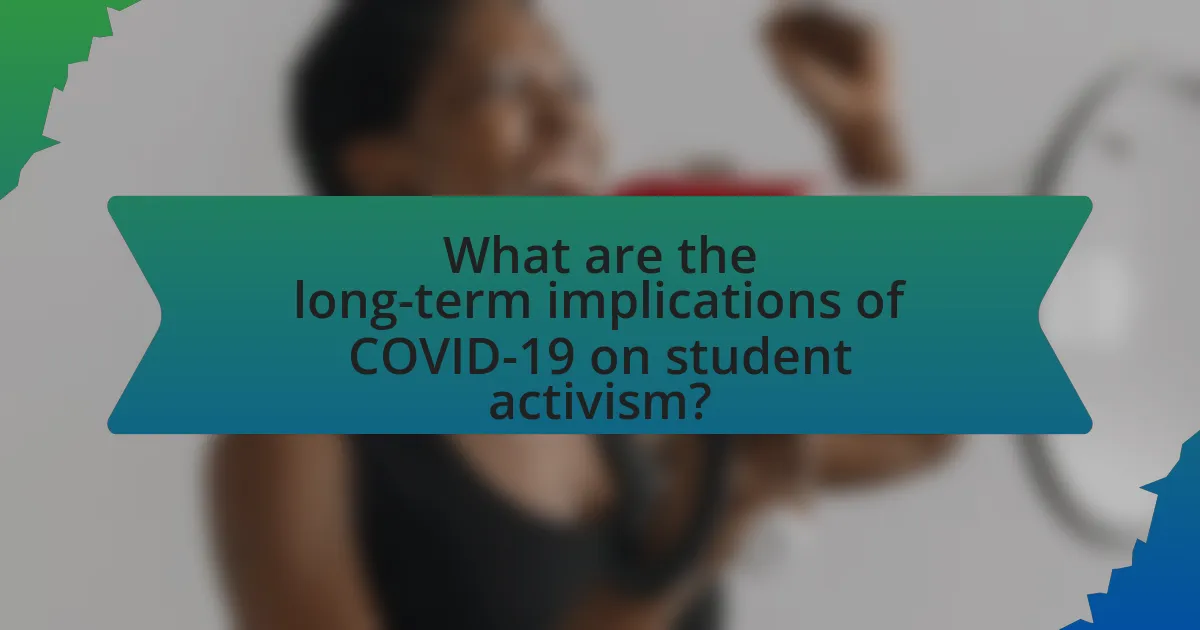
What are the long-term implications of COVID-19 on student activism?
The long-term implications of COVID-19 on student activism include a shift towards digital organizing and increased focus on social justice issues. The pandemic has accelerated the use of online platforms for mobilization, allowing students to reach broader audiences and engage in activism beyond geographical limitations. For instance, a study by the Harvard Kennedy School found that 70% of student activists reported increased online engagement during the pandemic, highlighting a significant transformation in how activism is conducted. Additionally, the heightened awareness of systemic inequalities during COVID-19 has led to a more pronounced emphasis on issues such as racial justice, mental health, and climate change within student movements. This evolution suggests that student activism will continue to adapt, leveraging technology and addressing pressing social issues in a post-pandemic landscape.
How might the experiences of student activists during the pandemic influence future movements?
The experiences of student activists during the pandemic are likely to influence future movements by fostering a greater reliance on digital platforms for organization and mobilization. During the pandemic, student activists adapted to remote engagement, utilizing social media and online tools to coordinate protests and raise awareness, as seen in movements like Black Lives Matter, which gained momentum through virtual campaigns. This shift to digital activism has demonstrated the effectiveness of online outreach, allowing for broader participation and engagement across geographical boundaries. Additionally, the pandemic highlighted issues such as mental health and educational inequities, prompting student activists to prioritize these concerns in future agendas, as evidenced by increased advocacy for mental health resources on campuses post-pandemic.
What lessons have been learned from the pandemic that can be applied to future activism?
The pandemic has highlighted the importance of digital engagement in activism, demonstrating that online platforms can effectively mobilize support and raise awareness. For instance, during COVID-19, social media campaigns like #BlackLivesMatter gained unprecedented traction, showing that virtual spaces can amplify voices and foster community even when physical gatherings are restricted. Additionally, the pandemic underscored the necessity for adaptability in activism strategies, as organizations quickly shifted to virtual events and campaigns to maintain momentum. This adaptability is crucial for future movements, as it allows activists to respond to changing circumstances and reach broader audiences.
How can student organizations prepare for future challenges in activism?
Student organizations can prepare for future challenges in activism by adopting flexible strategies that incorporate digital tools and community engagement. The COVID-19 pandemic has highlighted the importance of online platforms for organizing and mobilizing, as seen in the rise of virtual protests and social media campaigns. Research indicates that organizations that effectively utilize technology can reach broader audiences and maintain momentum during crises. For instance, the Black Lives Matter movement successfully leveraged social media to mobilize support and raise awareness during the pandemic, demonstrating the effectiveness of digital activism. By investing in training for digital advocacy and fostering partnerships with local communities, student organizations can enhance their resilience and adaptability in the face of future challenges.
What practical steps can students take to enhance their activism post-pandemic?
Students can enhance their activism post-pandemic by engaging in digital organizing, participating in local community initiatives, and collaborating with established advocacy groups. Digital organizing allows students to reach a wider audience through social media platforms, facilitating awareness campaigns and virtual events. Participation in local community initiatives, such as volunteering for food drives or environmental clean-ups, fosters direct impact and strengthens community ties. Collaborating with established advocacy groups provides students with resources, mentorship, and a platform to amplify their voices. These steps are supported by the increased reliance on digital communication during the pandemic, which has shown to effectively mobilize support for various causes.
How can students effectively collaborate with local communities for social justice?
Students can effectively collaborate with local communities for social justice by engaging in community-based projects that address specific local issues. This collaboration can take the form of organizing workshops, participating in local advocacy campaigns, or conducting research that highlights community needs. For instance, a study by the University of California found that student-led initiatives that partnered with local organizations resulted in increased awareness and action on social justice issues, demonstrating the effectiveness of such collaborations. By actively listening to community members and incorporating their perspectives, students can create meaningful partnerships that drive social change.
What resources are available for students looking to engage in activism?
Students looking to engage in activism can access various resources, including online platforms, local organizations, and educational institutions. Online platforms such as Change.org and social media networks provide tools for organizing campaigns and raising awareness. Local organizations, like the American Civil Liberties Union (ACLU) and local chapters of national movements, offer support, training, and networking opportunities. Educational institutions often have student-led groups and resources, such as workshops and funding for activism-related projects. These resources facilitate student involvement in social justice efforts, especially in the context of challenges posed by COVID-19, which has shifted many activities online and emphasized the need for virtual engagement.

